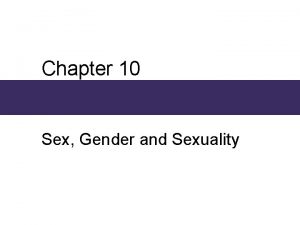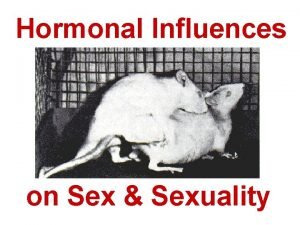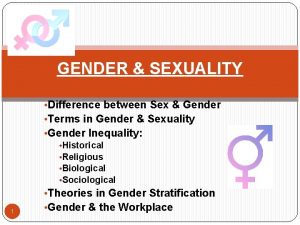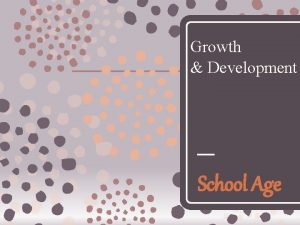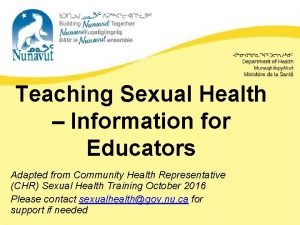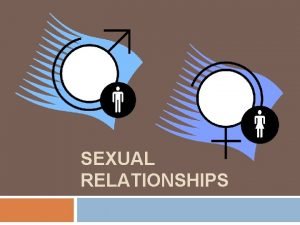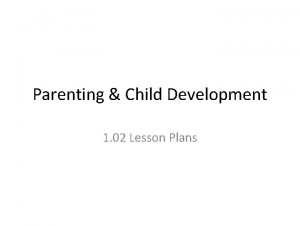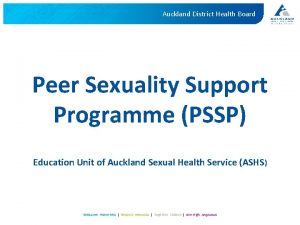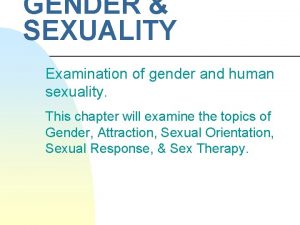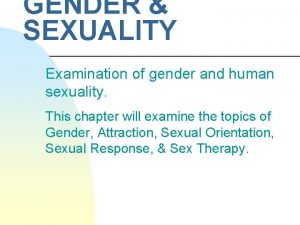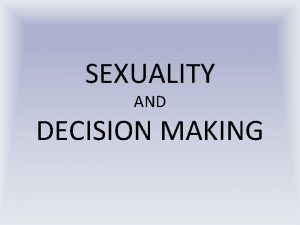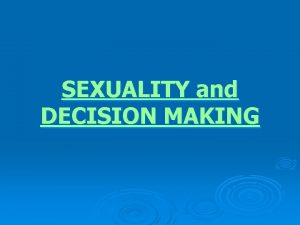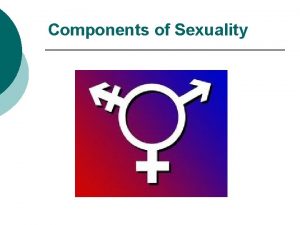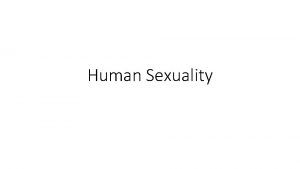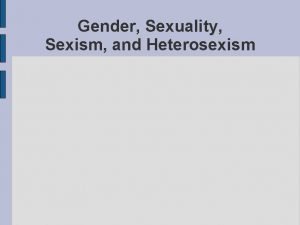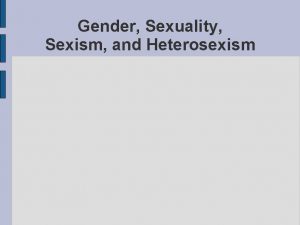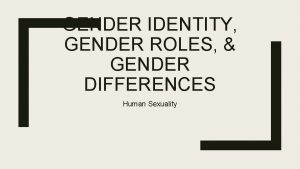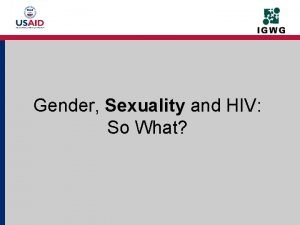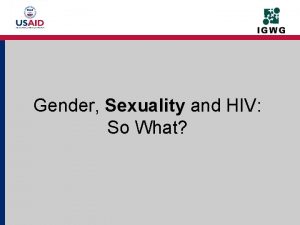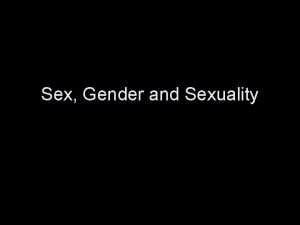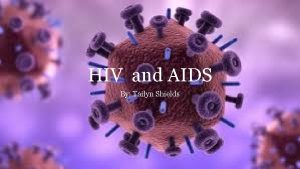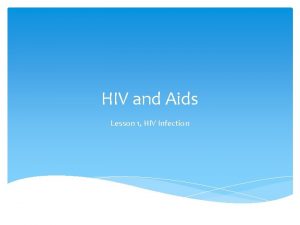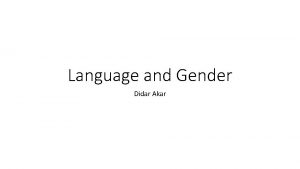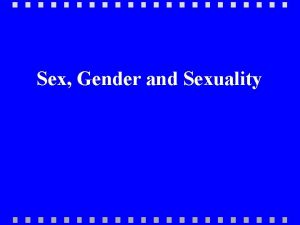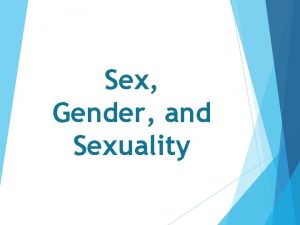Gender Analysis Integration for HIV and Sexuality Gender




























- Slides: 28

Gender Analysis & Integration for HIV and Sexuality

Gender Analysis

‘Know Your Epidemic’ & Steps of Gender Analysis 1. Review sexdisaggregated epidemiological and behavioral data Identify patterns for who is most infected and affected, geographic areas, modes of transmission, equity of access – “the what” 2. Identify underlying gender and sexual norms & inequalities ‘driving’ epidemic and its impact Analyze norms and inequalities in different domains (norms, practices, access to resources, decisionmaking) behind the epidemic’s patterns – “the why” 3. Look at how these norms and inequalities constrain or support HIV outcomes Determine how these norms and inequalities constrain or support • Risk and vulnerability • Living with HIV and those affected by HIV • Programmatic responses (prevention, treatment, care and support) – “the so what” Adapted from Jerome, J. and van den Oever P. 1994. Sex and Gender – What’s the Difference? : A Tool for Examining the Sociocultural Context of Sex Difference, in Genesys, the Futures Group with Management Systems International and Development Alternatives Inc, Gender Analysis Tool Kit. Office of Women in Development, USAID.

What is Gender Analysis? Gender analysis draws on social science methods to examine relational differences in women’s and girls’ and boys’ • roles and identities • needs and interests • access to and exercise of power and the impact of these differences in their lives and health.

How does Gender Analysis help us design and manage better health programs? Through data collection and analysis, it identifies and interprets … – consequences of gender differences and relations for achieving health objectives, and – implications of health interventions for changing relations of power between women and men.

Different approaches, but two fundamental questions • How will gender relations affect the achievement of sustainable results? • How will proposed results affect the relative status of men and women? (i. e. , will it exacerbate inequalities or accommodate or transform gender relations? )

To understand gender relations … Examine different domains of gender relations POWER § Practices, Roles, and Participation § Knowledge, Beliefs, and Perceptions § Access to Resources § Rights and. POWER Status

Different Contexts Gender constraints and opportunities need to be investigated in specific contexts, as they vary over time and across … Social Relationships • Partnerships • Households • Communities • Civil society and governmental organizations/institutions Sociocultural Contexts • Ethnicity • Class • Race • Residence • Age

What different constraints and opportunities do women and men face? • How do gender relations (in different domains of activity) affect the achievement of sustainable results? • How will proposed results affect the relative status of men and women (in different domains of activity)?

Different Domains of Gender Analysis Legal rights and status Knowledge, beliefs and perceptions Practices, roles and participation Access to assets

Different Domains of Gender Analysis Legal rights and status Knowledge, beliefs and perceptions Practices, roles and participation Access to assets

Gender and Sexuality Influence One Another Gender Sexuality

Practices, Roles, and Participation Gender structures peoples’ behaviors and actions —what they do (Practices), the way they carry out what they do (Roles), and how and where they spend their time (Participation). Participation • Activities • • Meetings Political processes Services Training courses

Knowledge, Beliefs, and Perceptions • Knowledge that men and women are privy to — who knows what • Beliefs (ideology) about how men and women and boys and girls should conduct their daily lives • Perceptions that guide how people interpret aspects of their lives differently depending on their gender identity

Access to Assets The capacity to access resources necessary to be a fully active and productive participant in society (socially, economically, and politically). Assets • • Natural and productive resources Information Education Social capital Income Services Employment Benefits

Legal Rights and Status Refers to how gender affects the way people are regarded and treated by both customary law and the formal legal code and judicial system. Rights • Inheritance • Legal documents • Identity cards • Property titles • Voter registration • Reproductive choice • Representation • Due process

Power Gender relations influence people’s ability to freely decide, influence, control, enforce, and engage in collective actions. 2005 Kevin Mc. Nulty, Courtesy of Photoshare Decisions about … • One’s body • Children • Affairs of household, community, municipality, and state • Use of individual economic resources and income • Choice of employment • Voting, running for office, and legislating • Entering into legal contracts • Moving about and associating with others

In short, Gender Analysis reveals … Gender-based Opportunities = gender relations (in different domains) that facilitate men’s or women’s access to resources or opportunities of any type. Gender-based Constraints = gender relations (in different domains) that inhibit men’s or women’s access to resources or opportunities of any type.

Moving from Analysis to Action: Lessons Learned • Gender analysis needs to investigate gender relations across multiple domains and levels • Sexuality across all of its dimensions needs to be explicitly included in gender analysis • Prioritizing is key to the focus and depth needed to tackle underlying gender relations • Successful gender-based interventions target at least two levels (are multi-level)

Example • In Kenya, HIV programming for young women in slums • Increased attention to economic constraints • But neglect of sex and sexuality per se Ø “HIV is still being spread under the programming surface” -Mohammed 2004

Integrating Gender into the Program Cycle

Strategic Information and Program Life Cycle ASSESSMENT What is the nature of the (health) problem? 1 EVALUATION How do I know that the strategy is working? How do I judge if the intervention is making a difference? STRATEGIC PLANNING 2 5 4 MONITORING How do I know the activities are being implemented as designed? How much does implementation vary from site to site? How can the program become more efficient or effective? What primary objectives should my program pursue to address this problem? 3 DESIGN What strategy, interventions, and approaches should my program use to achieve these priorities?

Moving from Analysis to Action: Practical Steps Based on the analysis of gender constraints and opportunities. . . 1. Specify sub-objectives and activities 2. Tie indicators to change in specific gender constraints and opportunities

Integrating Gender Into Programming (Table 1) Program goal and/or overall health objective: _________________________ Step 1: Conduct a gender analysis of your program by answering the following questions for y program goal or objective. A. What are the key gender relations inherent in each domain (the domains are listed below) that affect women and girls and men and boys? B. What other potential information is missing but needed about gender relations? C. What are the genderbased constraints to reaching program objectives? D. What are the gender-based opportunities to reaching program objectives? Be sure to consider these relations in different contexts—individual, partners, family and communities, healthcare and other institutions, policies Be sure to consider these gender relations as they affect different dimensions (circles) of sexuality. Practices, roles, and participation Knowledge, beliefs, perceptions (some of which are norms): Access to assets: Legal rights and status: Power and decision making:

Integrating Gender into Programming (Table 2) Steps 2 -5: Using the information you entered in Table 1, answer the following questions for your program goal/objective. Step 2. What gender-integrated objectives can you include in your strategic planning to address gender-based opportunities or constraints? Step 3. What proposed activities can you design to address gender-based opportunities or constraints? Steps 4 & 5. What indicators for monitoring and evaluation will show if (1) the gender-based opportunity has been taken advantage of or (2) the gender-based constraint has been removed?

Small Group Work Instructions for Exercise • Read your assigned case study, considering your group’s focus • See flipchart for your group’s details • Complete Table 1, identifying gender-based opportunities, constraints, and missing information • Complete Table 2, identifying gender sub-objectives, activities, and indicators • Record highlights of your responses on flipchart paper

Getting Started: Available Resources • USAID Interagency Gender Working Group http: //www. igwg. org • USAID Global Health http: //www. usaid. gov/ our_work/global_health/ • USAID Women in Development Office http: //www. usaid. gov/ our_work/cross-cutting_ programs/wid/ • PEPFAR Gender Technical Working Group 2006 Elizabeth Neason

Thank You!
 Chapter 10 sex gender and sexuality
Chapter 10 sex gender and sexuality Sex
Sex The difference between sex and gender
The difference between sex and gender Strategic gender needs and practical gender needs
Strategic gender needs and practical gender needs Pretest growth development and sexuality
Pretest growth development and sexuality Integration of gender roles in school and curriculum
Integration of gender roles in school and curriculum Three dimensions of corporate strategy
Three dimensions of corporate strategy Make or buy continuum
Make or buy continuum Simultaneous integration example
Simultaneous integration example Sexuality in advertising
Sexuality in advertising What are the four intertwining strands of sexuality?
What are the four intertwining strands of sexuality? It is the awareness, acceptance of comfort one's body.
It is the awareness, acceptance of comfort one's body. Definition of sexuality
Definition of sexuality Definition of sexuality
Definition of sexuality Which illustrates an emotional aspect of teen sexuality?
Which illustrates an emotional aspect of teen sexuality? Peer sexuality support programme
Peer sexuality support programme Base of uterus
Base of uterus Sexuality spectrum
Sexuality spectrum A bacterial std that usually affects mucous membranes
A bacterial std that usually affects mucous membranes Chapter 24 sexually transmitted diseases and hiv/aids
Chapter 24 sexually transmitted diseases and hiv/aids Fspos vägledning för kontinuitetshantering
Fspos vägledning för kontinuitetshantering Novell typiska drag
Novell typiska drag Tack för att ni lyssnade bild
Tack för att ni lyssnade bild Returpilarna
Returpilarna Shingelfrisyren
Shingelfrisyren En lathund för arbete med kontinuitetshantering
En lathund för arbete med kontinuitetshantering Personalliggare bygg undantag
Personalliggare bygg undantag Personlig tidbok fylla i
Personlig tidbok fylla i Sura för anatom
Sura för anatom
